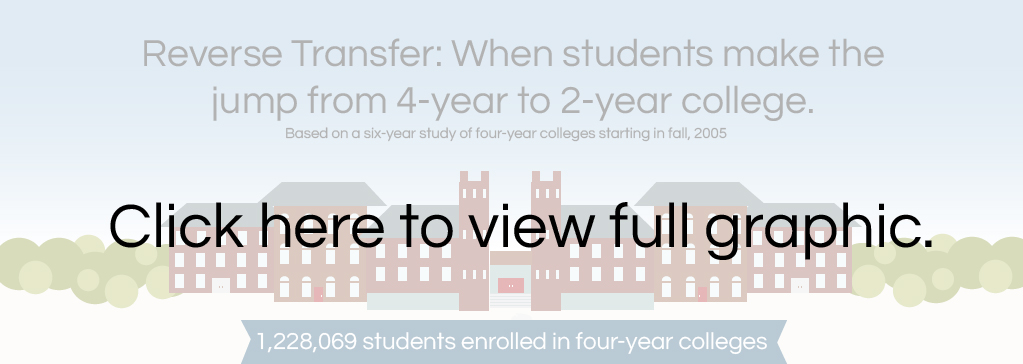You have /5 articles left.
Sign up for a free account or log in.
Large numbers of students at four-year institutions are transferring to community colleges, according to a new study from the National Student Clearinghouse Research Center. Most of them don’t come back, but that isn’t always a bad thing.
Roughly 14 percent of first-time students who enrolled at a four-year institution in the fall of 2005 had transferred to a community college by 2011, the study found -- excluding students who merely took summer classes at a community college.
Of the transfer group, about 17 percent eventually returned to their original four-year institution. A larger group, about 28 percent, went on to a different four-year. The other 55 percent either stuck it out at community colleges or dropped out, with that group split right down the middle.
The research sheds light on the “reverse transfer” pathway for students, which may be growing in popularity. There are many reasons students make the jump to a community college from a four-year institution, including some students' academic and financial struggles. But contrary to conventional wisdom that the two-year path is inferior, reverse transfer can benefit students.
“While reverse transfer may not be the best indicator for students aiming to complete a bachelor’s degree, it is clearly a positive indicator for students transitioning to a more direct route to a shorter degree completion,” the report said. It is also “certainly preferable to withdrawing from a four-year institution and dropping out of higher education altogether.”
For example, the research suggests that some students leave their four-year colleges because of “fit,” and then later transfer to a different four-year college after regaining their academic footing at a community college, said Doug Shapiro, executive research director at the center and one of the study’s co-authors.
“Students are using community colleges to serve all kinds of needs,” Shapiro said.
Those needs may include transferring to a two-year college to get a more practical degree for a tight job market. (This may even apply to graduates of four-year institutions, as the Milwaukee Journal Sentinel recently reported.) Or, in some cases, students take classes at community colleges to accelerate their path to a bachelor’s degree.
To wit, students who enroll in summer classes at a community college are more likely to earn a degree from their four-institution than those who don’t. About 78 percent of students at four-year institutions who enrolled in a community college for a summer session and then returned to their original institution successfully earned a degree, according to the report, substantially outpacing the 58 percent graduation rate of those who never attended a community college.
“It clearly is a very effective strategy,” said Shapiro.
Giving Credit to Community Colleges
Of course, not all the news is good. After six years, two-thirds of reverse transfer students neither had a credential from a four-year college nor were enrolled at one, according to the study. And of the roughly 55 percent of reverse transfer students who do not return to the four-year sector, about half dropped out. (The rest either earned a credential from a community college or were still enrolled at one.)
The National Student Clearinghouse is a nonprofit that offers verification and research services to participating colleges, which voluntarily hand over their enrollment and degree information. Its members account for 96 percent of the nation’s college students.
As a result, the center was able to track 1.3 million students who enrolled at four-year institutions in 2005 -- virtually all of the total new enrollment for that year -- and see where those students went over the next six years.
The resulting data is somewhat squishy, however, and is more of a broad snapshot of enrollment and transfer trends. That’s because, as Shapiro acknowledges, the study was not able to get a great amount of detail on the enrollment status of students. For example, determining the definition of “transfer” status can be difficult, particularly for community college students, who tend to bounce around.
More sophisticated, longitudinal studies use smaller data sets from the National Center for Education Statistics. In particular, Clifford Adelman, a senior associate with the Institute for Higher Education Policy, has conducted such research.
However, the center’s new study gives a national glimpse of the reverse transfer trend. It also builds on a recent study from the center that found increasing mobility among students.
Shapiro hopes the new report will help policy makers and others see the broad role community colleges play. Too often, he said, community colleges are taken to task for relatively low graduation rates without getting credit for serving students along complex transfer pathways.
The study could also help four-year institutions determine when it makes sense to try to bring back students who have transferred out to community colleges. Don’t wait too long, Shapiro said, noting that students are much more likely to return to four-year institutions after a short stint at community colleges.
“The likelihood of returning to the original institution drops off pretty substantially after one semester,” he said.









